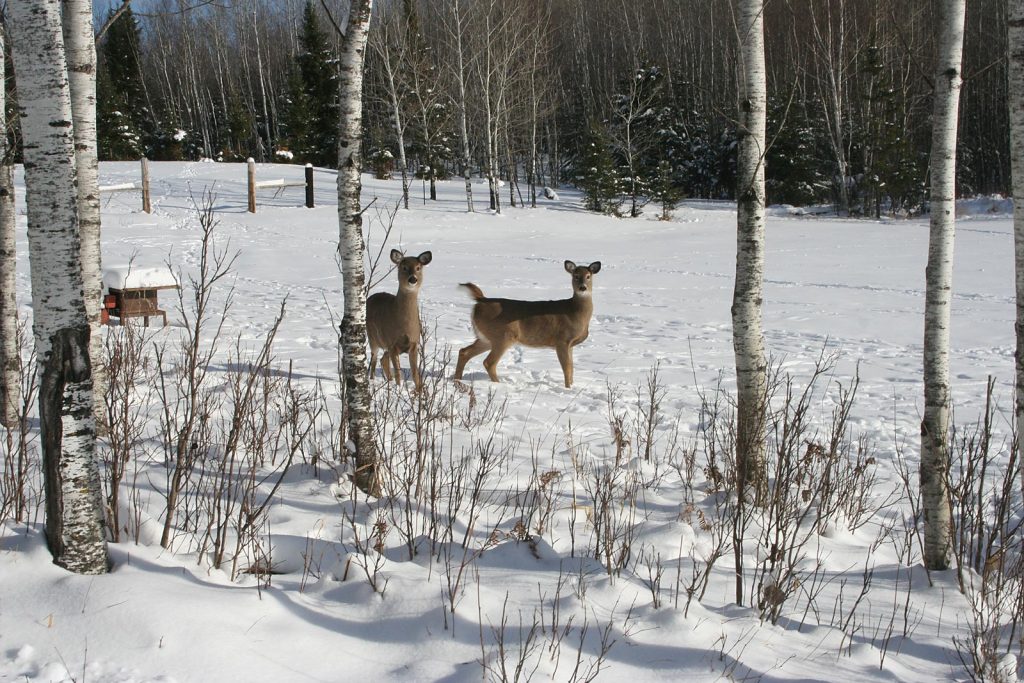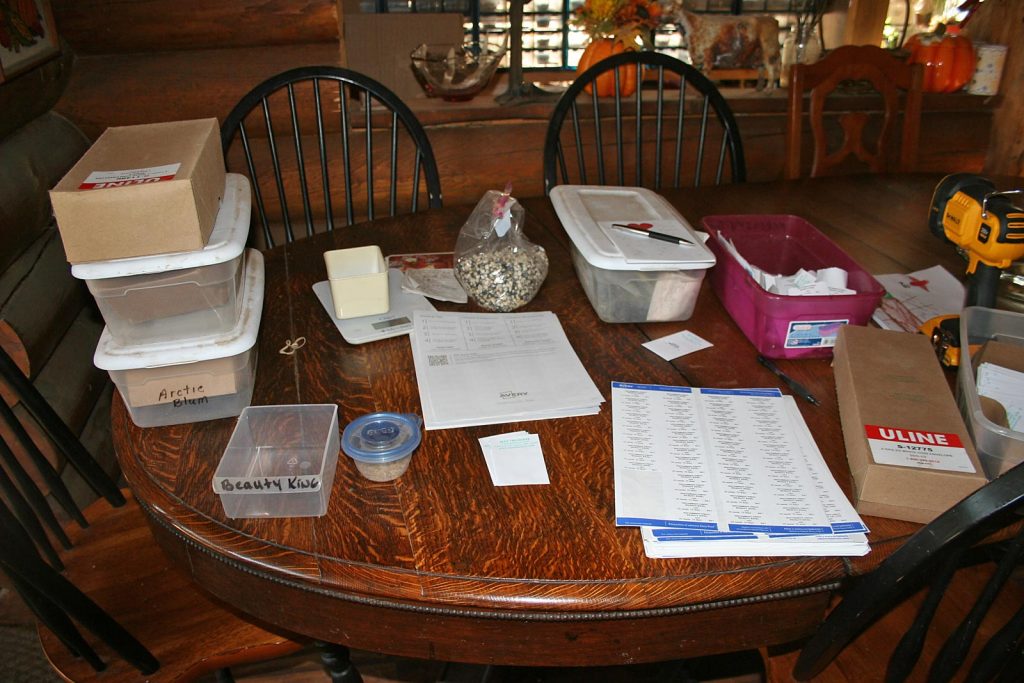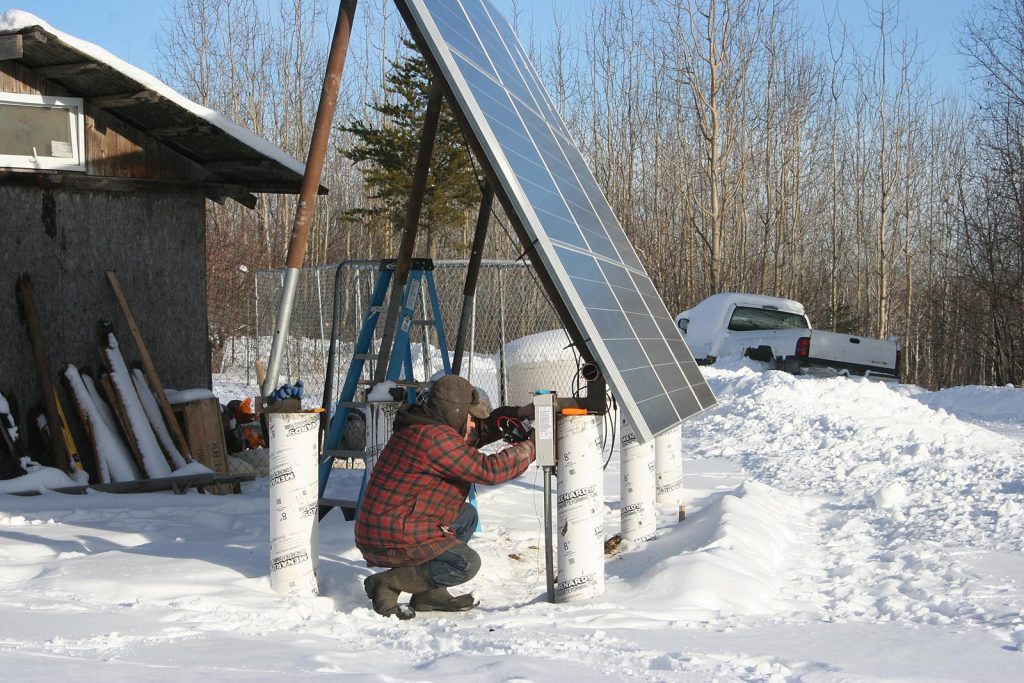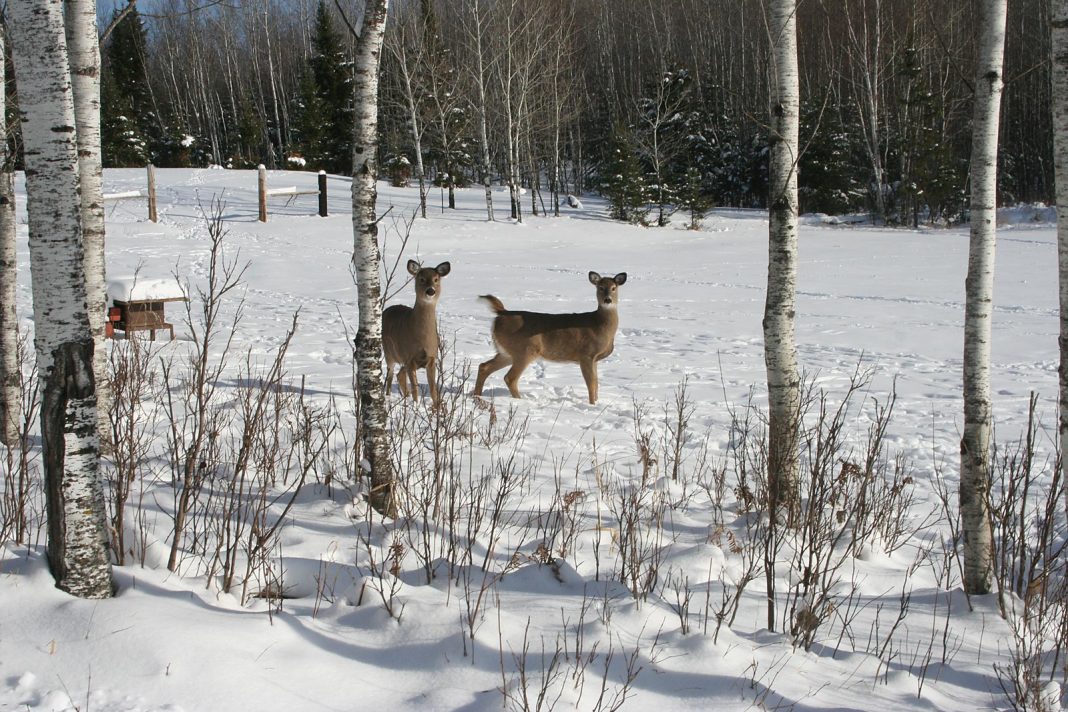
It’s amazing how much gets done when the sun is out! I really think the sun increases your energy in the winter. Besides, when it’s above 30 outside chores are so much more pleasant. I took the four wheeler out to feed the deer on the trail in the East pasture and found them already waiting. They like the sun too! Watering the cows and horses today was actually a pleasure. As I stood watching them come to drink and walk about, I spotted several deer in the woods and a beautiful Bald Eagle flew close overhead — very nice against a blue sky. One of our stock tanks is getting a lot of ice build-up so Will is going to dig out one of our wood-fired stock tank heaters. Although you do have to keep putting wood in them every half hour to hour, they thaw out a tank full of ice quickly so the animals can drink warm water. (If you’d like more information on building your own wood-fired stock tank heater, check out my article in Issue 138 of Backwoods Home or the Twenty-third Year Anthology.)
Will and Hondo went to get our mail and I was pleasantly surprised to find the first “new” issue of Backwoods Home. I stopped everything and sat down to read. How exciting to see our good old favorite back in print again! I never did get the most out of my Kindle … I guess I’m just old.
I’ve been busy packaging seeds like mad. As our catalog will soon be out, I’m sure plenty of folks will be — just like me — planning their Spring gardens and will need seeds to fill it. Seeds for plants you can save your own seeds from, come fall. (You not only plant history but also save a bundle by planting open pollinated seeds.) I can’t get over it; seed saving was so common in Mom and Grandma’s day. Today it’s a lost art that is thankfully, coming back.

Will spent most of the day working on our new solar array. He got a lot done and said it was so much faster today than working at -27. I guess so! He’s got the combiner box all wired and tested; the panels are doing their job well. Now he’s working in the basement, mounting the charge controllers on a piece of plywood which is mounted to the block wall. All in all, we’ll end up with five charge controllers as we have not only the new panels and our “old” ones, but also a bunch of older-style panels in the basement which will be mounted down by the duck house, feeding electricity into the house. Wow, we won’t know how to handle all that electricity. (No, we can’t sell it back to the power company; we’re more than a mile from a power line!)

I’ve got a bunch of dry beans I want to get canned up as they’re just so handy to have in the pantry — no long cooking when you want to have beans. I’ve done chili but next is pintos for refried beans and some baked beans, which are like Campbell’s Pork and Beans but with more pork and not so watery. Yum! — Jackie




Thanks, Jackie for sharing this recipe. I really appreciate it.
I would love to get all your recipe/canning books but it is very difficult to get them in Canada without paying exhorbitant shipping costs. I tried to buy them when BHM had them on sale but the shipping charge was more than double the cost of the books! The only two major booksellers in Canada do not carry them.
I don’t read electronically and prefer print copies of the cookbooks/canning book. Unfortunately, Indigo Chapters has none of your cookbooks. Amazon Canada has ONE copy of your cookbook and it is selling for $300. I tried Amazon U.S. but the cost there is $187. Much as I love ya, Jackie, I just cannot afford these prices.
Sigh! Maybe one day I can visit a homestead expo in the U.S. where BHM has a booth with your books or perhaps be able to attend one of your homesteading seminars and buy them directly from you.
Shipping costs to Canada are really awful. Even in our seed business we see it. Shipping a few packs of tomato seeds racks up a $10+ postage bill. I hope some day you will be able to attend one of the expos or our seminars. (You can also just come down for a visit and take the books home with you….) Smile.
Donna, have you tried searches on ABEBooks.com? I just checked their used book listings for Jackie’s books using an author name search, and I used both Jackie Clay and Jackie Clay-Atkinson. ABE bookseller prices are usually very reasonable and there’s a table for shipping to Canada either slow (about a month) or fast (expensive). I didn’t think the shipping was out of line. You can sort the returns different ways – I used lowest total price. One of Jackie’s books has an asking price of about $1,500.00 (not a typo). Her Jess Hazzard books (paperback) are listed at about $12 up to $99 each. I have no way to know how the individual booksellers price their items. If you know someone in the US who would buy the books for you and ship them there may be a lower shipping rate for media or for items declared as personal gifts. I think you can have Jackie’s books for much less total cost than you’ve been given. I’ve bought a lot of used books at ABE including rare items and all have been exactly as described. You can trust their sellers.
Hi Jackie! Just got my first issue of the New BWH and it feel like an old friend come to visit. It has the same look and the same writers and I am saving it to read on a cold snowy night by the fire. Not really, I’m reading it now… It sure will feel great for you to get paid from the electric company!!! Our electric bills here south of Superior WI are ridiculously high. Enjoy your panels! I love your blog!
I got my issue of BHM yesterday and sat down to snuggle up and read. How nice that was!!!
You misunderstood; we won’t get paid from our power company as we don’t have one. Our powerlines are over a mile way and we wouldn’t bring them in if we could afford to. Will has them hooked up and making power today. Hooray!!!
Miss Jackie, I haven’t got my print issue of the mag yet, but I am anticipating it!! Lovely photo of the deer in 1st pic. Are the white bark trees white birch or aspen or…??? Neither is native to my area, but some people use the birch as a specimen tree, but they are not too long lived here. To the left of the trees is what looks like a honeybee stand with snow on the top. Could it be so??? You can’t know how much I love to have and work with bees. It is equal with canning to me; I wouldn’t like to forfeit either joy. Blessings Rick
You should have your issue in the mailbox, Rick. I got mine yesterday!
The trees are what we call “poplar” here but “aspen” in Montana. They are so white that when Will came, he thought they were birch, too. Naw, that’s Will’s “mini-cordwood saw” which is a circular table saw he retrofitted to be driven with a Briggs and Stratton motor. We’d love to have bees; I had them way back, years ago, in Sturgeon Lake, MN. But Will has been VERY allergic to stings. He’s much better now and hasn’t had to use an Epi-pen for several years. Maybe soon??? We hope so but aren’t taking chances, either. I LOVE bees!!!
Isn’t that funny, here in NC,what we call poplar isn’t white at all. It’s very straight in trunk and grain, with broad leaves, smoth dark bark. Good for trim and moldings. Our only “white ” trees are ashe or sycamore.
Pastor Rick, good to hear from you too!
I opened the first jar of lentils last night, that I recently canned up following your instructions for old beans. They were perfect. I’ve used your canning book many times, and it’s been so helpful. This winter, I have a goal to try some of the recipes in it too. It seems the rain will never end here in NC, but this too shall pass.
Yes, it will, Laurie. I’m tickled you canned up some lentils. I’m getting ready to do up a batch of pintos real soon. Such a good use of “old” beans that don’t seem to want to get tender. When you can them, they get tender in a jiffy.
For folks who don’t pressure can, you can make the oldest dry beans tender enough to cook in a short time by brining them. The recipe originally came from Cook’s which researches a lot of cooking methods. For each pound of dry beans stir very well to dissolve 3 tablespoons of salt (do NOT use iodized) in 4 quarts of cold water. Make sure the salt is totally dissolved. Soak the beans at room temperature (I cover them) for 8 to 24 hours (I’ve soaked for slightly longer). Drain and rinse well several times (and I let them sit in plain water for at least 15 minutes). Cook as you want, plain or seasoned. Even the oldest hardest beans will soften in about half the time you would expect. The beans will be creamy inside with soft skins. I’ve used this method since it appeared on the Cook’s site on many different kinds of beans and it works every time. You can freeze the plain brined cooked beans for your favorite recipe. (I don’t can).
I would love that recipe too!!! They’re so expensive in the store and it can be one more addition to our food supply in the cellar.
My recipes for canning dry beans of all sorts can be found in my book, Growing and Canning Your Own Food, available through BHM. I love having a huge variety in my pantry!!
I have been a stalker reading just about everything you write I just love the simple down to earth style you have ? just can’t get enough love love love
I have a question on your canning class in the self reliance magazine can you message me which magazines the class is in thank you
I believe the class ran from the first printed issue of SR through the fourth or fifth.
I checked to make sure, Gina. Canning Class ran from the Fall 2016 issue of SR (Vol 1, Issue 2) to Spring of 2018 (Vol 3, Issue 1)
I too love to can up dried beans for “quick” meals. Do you soak yours first or do you just put the dried beans directly in the jar, fill with water and then process ? I have found that an easy way to can them and if I’m canning meat and have leftover space I can add a few jars of dried beans to fill the canner.
I usually use the “quick” method, found on page 126 of Growing and Canning Your Own Food. This is; rinse and dry beans, cover well with boiling water. Boil 2 minutes. Remove from heat and let soak, covered, for 2 hours. Heat to boiling and drain, saving liquid. Pack jars 3/4 full with hot beans. Add small piece of fried lean bacon or ham if desired. Fill with hot cooking liquid, leaving 1 inch of headspace. Process pints for 75 minutes and quarts for 90 minutes at 10 pounds pressure.
I guess I’m old too Jackie, I can’t read too much on an electronic device. Hurts my eyes. Besides I like to underline and show stuff to my husband. I’m so glad BWH is back in print.
I can’t wait to see what all you have for sale for seeds this year. My garden is small and I will have to be super selective on all I plant. It’s so hard to decide what to plant.
This is my first winter in zone 5b boy is it warm. I have to say I love it.
I fantasize about living in Zone 5 but we’re here for good. And we do live it! I hope you find just what you’d like to plant in our new catalog.
Can you share your canned pork and beans recipe?
Yes, please share. I admit, I love Campbell’s pork n beans. Never been able to duplicate it.
Sure things, gals. Here it is. I think mine is better than Campbell’s though. Just saying….
PORK AND BEANS WITH TOMATO SAUCE
2 qts dried navy or Great Northern beans
1/2 pound bacon or salt pork, cut into small pieces
2 C chopped onion
8 Tbsp brown sugar
1/2 tsp. allspice
1/2 tsp ground cloves
1 qt tomato juice
Cover beans well with water and let stand overnight. Drain. Cover beans with boiling water by 4 inches in a large stock pot. Boil 3 minutes. Remove from heat and let stand 10 minutes. Drain. Combine other ingredients except for bacon or pork. Bring to a boil. Pack 1 cup beans into hot jars. Top with a piece of pork or bacon. Fill jar 3/4 full with more beans and add another piece of pork. Then ladle hot tomato sauce over beans, leaving 1 inch of headroom. Remove any air bubbles; wipe rim clean, place hot, previously simmered lid on jar and screw down ring firmly tight. Process pints for 65 minutes and quarts for 75 minutes at 10 pounds pressure. Be sure to adjust your pressure to suit your altitude if you live above 1,000 feet. Consult your canning book.
Note; some folks like their beans more liquid, like Campbell’s. If you do, just add fewer beans so the sauce will be more liquid.
Comments are closed.